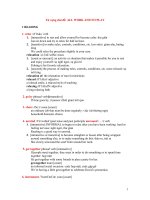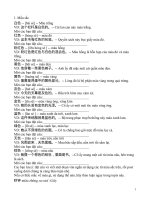Toeic theo chủ đề 4 ppsx
Bạn đang xem bản rút gọn của tài liệu. Xem và tải ngay bản đầy đủ của tài liệu tại đây (66.14 KB, 6 trang )
HOW TO USE THIS BOOK TO GET A TOP SCORE 7
■
Review your current activities and obligations,
including recurring ones like classes, your work
schedule, your exercise or sports schedule, or religious
services.
■
Prioritize your activities. Which are the most
important to you? Are there any activities you can
eliminate to make more time to prepare for the TOEFL
exam?
■
Work out a weekly schedule. Make a list of your major
weekly events, including your TOEFL exam study goals
for the week. (See more about creating a successful study
plan later in this chapter.) List any major social, work, or
school-related events (for example, a vocabulary test in
Register Right Away
Test centers fill up quickly, so begin the TOEFL exam
registration process right away. Registration information is
available online at www.toefl.org or in the TOEFL exam
Bulletin, available at English language centers or at the
international student center at the university to which you
are applying. You can also request a Bulletin by writing to:
TOEFL/TSE Services
P.O. Box 6151
Princeton, NJ 08541-6151
609-771-7100
8 TOEFL EXAM ESSENTIALS
English class). Ideally, create this schedule for each week
of your test preparation period.
■
Create a daily “to do” list. Write down your activities,
including your TOEFL exam study goals for the day.
Make this list daily, before bed, or first thing in the
morning. Carry it with you and cross out the items that
you have accomplished.
Managing your time effectively while you are actually taking
the TOEFL exam is a crucial skill. As outlined earlier in this chap-
ter, each section of the TOEFL exam has a specific time limit.
You are expected to complete each section within that given
amount of time. Because you know how much time you have, you
can pace yourself and budget the amount of time you would like
to spend on each question.
If you are taking the computer-based TOEFL exam, an
onscreen clock display will keep track of the current question num-
ber, the total number of questions, and the time you have left to
answer them. For example, if you are halfway through a section
with 30 questions, you may see a display that shows question 15
of 30 and 00:09 minutes remaining. The display continuously
changes as you go through the section.
To help you manage your time during the exam, review these
guidelines:
■
Sharpen your computer skills if you are taking the
computer-based exam. Even if you use a computer every
day, taking a test on a computer may be unfamiliar to
you. Go to the TOEFL exam website (www.toefl.org)
for free online tutorials before exam time.
HOW TO USE THIS BOOK TO GET A TOP SCORE 9
■
Take a practice test and time yourself. For a 20-
question practice test with a time limit of 40 minutes,
give yourself about two minutes for each practice
question. This will help you learn to pace yourself.
■
Read the directions before you begin each section.
The total number of questions and the time allotment
are listed at the start of each section—carefully review it,
even if you think you already know the information. The
number of questions may vary because the test
developers sometimes add questions for research
purposes. They do this to determine whether a new
question for a future test is sufficiently clear. These
questions are not scored and you will not know which
ones they are.
■
Eliminate incorrect answer choices. Most of the
questions used in the TOEFL exam are multiple-choice.
For each question, you will have a set of four possible
answers. Read the questions carefully and eliminate the
answer choices you know are incorrect. This will make it
easier for you to find the correct answer.
■
Do not spend too much time on any one question. If
you do not know the answer, eliminate as many answer
choices as possible and then choose your best answer.
Do not make a random guess unless absolutely necessary
for you to move on to the next question. On the
computer-based exam, the listening and structure
portions of the test (the computer-adaptive parts of the
test), do not allow you to skip questions or return to
them later. Once you click the “Confirm Answer”
10 TOEFL EXAM ESSENTIALS
button on your computer screen, you cannot change
your answer. Random guessing, however, can reduce
your score. Fortunately, in the reading section, you can
make note of a difficult question and go back to it after
you have completed the rest of the questions. Likewise,
on the paper-and-pencil version of the test, you can
answer questions in the order that you wish.
■
Try to finish each section if you are running out of
time. This does not mean you should make random
guesses—again, doing so can significantly lower your
score on the CBT. However, evidence shows that most
test takers will score higher if they answer all the
questions than if they do not try to complete the test.
Here are some other tips for answering multiple-choice
questions:
■
Watch for tricky wording. Some questions use
wording such as “All of the following are true except” or
“Which of the following is not a likely outcome?” You
will find answer choices that are accurate, but do not fit
the question.
■
Look out for absolutes. Be careful answering questions
that use words such as always, never, none, or all. You may
find answer choices that sound correct but are not true
in every circumstance.
■
Beware of silly answer choices. Test makers often
include silly or easily confused answer choices. When
you are under pressure, these choices can become
HOW TO USE THIS BOOK TO GET A TOP SCORE 11
appealing if you are not reading closely. Eliminate these
options first.
CREATE A STUDY PLAN
Have you ever crammed for a big test, trying to learn everything
at the last minute? If you have, you know that you can’t learn all
the material for a major exam in one study session. And if you stayed
up all night cramming, you probably found out that you were too
tired to study effectively. A study plan creates a framework for you
to follow as you prepare for the TOEFL exam. By planning ahead,
you can break down your studying into smaller blocks of time that
are easier to manage, less intimidating, and more effective.
To implement a study plan, first consider your study envi-
ronment. You will need a place to study that has a minimum of
distractions, a location where you can concentrate and spread out
your materials. Your study environment should also be well lit and
Should You Guess?
In most cases, the answer is yes—if you can eliminate at
least one answer. On the computer-based TOEFL exam,
random guessing will lower your score. Only guess if you
can cross out at least one answer. On the paper-based
TOEFL exam, however, your score is based on the number
of questions you answer correctly. Because there is no
penalty for wrong answers, you should guess even if you
can’t eliminate one or more answer choices.
12 TOEFL EXAM ESSENTIALS
comfortable for you. A corner of your bedroom, a study in your
home, the local library, or your school are all possibilities. Once
you have a place to work, collect the study tools you will need.
With study tools in hand and a place to study, it’s time to col-
lect the information you need to make decisions about what to
study and how much time to allocate to each area of study.
Follow these five steps to create an effective study plan:
1. Get the information you need. Find out the details
about the TOEFL exam, including:
When will it be held?
Where is the test center nearest you?
How do you register?
What do you need to register?
How much does it cost?
What You Need Before You Start
To make your TOEFL exam study time more effective, get
the right study tools. Here are some suggestions:
■
a good English-language dictionary, such as Merriam-
Webster’s Collegiate Dictionary, 11th Edition
■
paper or legal pads
■
pencils or pens
■
highlighter pens in different colors
■
index or note cards
■
notebooks and folders
■
calendar or Personal Digital Assistant, such as a Palm
Pilot™









